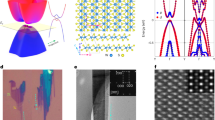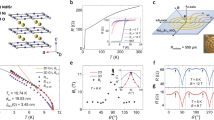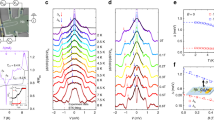Abstract
The strong Ising spin–orbit coupling in certain two-dimensional transition metal dichalcogenides can profoundly affect the superconducting state in few-layer samples. For example, in NbSe2, this effect combines with the reduced dimensionality to stabilize the superconducting state against magnetic fields up to ~35 T, and could lead to topological superconductivity. Here we report a two-fold rotational symmetry of the superconducting state in few-layer NbSe2 under in-plane external magnetic fields, in contrast to the three-fold symmetry of the lattice. Both the magnetoresistance and critical field exhibit this two-fold symmetry, and it also manifests deep inside the superconducting state in NbSe2/CrBr3 superconductor-magnet tunnel junctions. In both cases, the anisotropy vanishes in the normal state, demonstrating that it is an intrinsic property of the superconducting phase. We attribute the behaviour to the mixing between two closely competing pairing instabilities, namely the conventional s-wave instability typical of bulk NbSe2 and an unconventional d- or p-wave channel that emerges in few-layer NbSe2. Our results demonstrate the unconventional character of the pairing interaction in few-layer transition metal dichalcogenides and highlight the exotic superconductivity in this family of two-dimensional materials.
This is a preview of subscription content, access via your institution
Access options
Access Nature and 54 other Nature Portfolio journals
Get Nature+, our best-value online-access subscription
$29.99 / 30 days
cancel any time
Subscribe to this journal
Receive 12 print issues and online access
$209.00 per year
only $17.42 per issue
Buy this article
- Purchase on Springer Link
- Instant access to full article PDF
Prices may be subject to local taxes which are calculated during checkout




Similar content being viewed by others
Data availability
Data for figures (including Supplementary figures) are available in the public repository Zenodo at https://doi.org/10.5281/zenodo.4545917. Source data are provided with this paper.
Code availability
All relevant codes needed to evaluate the conclusions in the paper are available from the corresponding authors upon reasonable request.
References
Revolinsky, E., Lautenschlager, E. P. & Armitage, C. H. Layer structure superconductor. Solid State Commun. 1, 59–61 (1963).
Xiao, D. et al. Coupled spin and valley physics in monolayers of MoS2 and other group-VI dichalcogenides. Phys. Rev. Lett. 108, 196802 (2012).
Mak, K. F., He, K., Shan, J. & Heinz, T. F. Control of valley polarization in monolayer MoS2 by optical helicity. Nat. Nanotechnol. 7, 494–498 (2012).
Zeng, H., Dai, J., Yao, W., Xiao, D. & Cui, X. Valley polarization in MoS2 monolayers by optical pumping. Nat. Nanotechnol. 7, 490–493 (2012).
Mak, K. F., McGill, K. L., Park, J. & McEuen, P. L. The valley Hall effect in MoS2 transistors. Science 344, 1489–1492 (2014).
Jones, A. M. et al. Spin-layer locking effects in optical orientation of exciton spin in bilayer WSe2. Nat. Phys. 10, 130–134 (2014).
Riley, J. M. et al. Direct observation of spin-polarized bulk bands in an inversion-symmetric semiconductor. Nat. Phys. 10, 835–839 (2014).
Xi, X. et al. Ising pairing in superconducting NbSe2 atomic layers. Nat. Phys. 12, 139–143 (2016).
Xu, X., Yao, W., Xiao, D. & Heinz, T. F. Spin and pseudospins in layered transition metal dichalcogenides. Nat. Phys. 10, 343–350 (2014).
Ugeda, M. M. et al. Characterization of collective ground states in single-layer NbSe2. Nat. Phys. 12, 92–97 (2016).
Moncton, D. E., Axe, J. D. & DiSalvo, F. J. Neutron scattering study of the charge-density wave transitions in 2H-TaSe2 and 2H-NbSe2. Phys. Rev. B 16, 801–819 (1977).
Harper, J. M. E., Geballe, T. H. & DiSalvo, F. J. Thermal properties of layered transition-metal dichalcogenides at charge-density-wave transitions. Phys. Rev. B 15, 2943–2951 (1977).
Fletcher, J. D. et al. Penetration depth study of superconducting gap structure of 2H-NbSe2. Phys. Rev. Lett. 98, 057003 (2007).
De La Barrera, S. C. et al. Tuning Ising superconductivity with layer and spin–orbit coupling in two-dimensional transition-metal dichalcogenides. Nat. Commun. 9, 1427 (2018).
Clogston, A. M. Upper limit for the critical field in hard superconductors. Phys. Rev. Lett. 9, 266–267 (1962).
Chandrasekhar, B. S. A note on the maximum critical field of high-field superconductors. Appl. Phys. Lett. 1, 7–8 (1962).
Möckli, D. & Khodas, M. Magnetic-field induced s + if pairing in Ising superconductors. Phys. Rev. B 99, 180505 (2019).
Möckli, D. & Khodas, M. Robust parity-mixed superconductivity in disordered monolayer transition metal dichalcogenides. Phys. Rev. B 98, 144518 (2018).
Yuan, N. F. Q., Mak, K. F. & Law, K. T. Possible topological superconducting phases of MoS2. Phys. Rev. Lett. 113, 097001 (2014).
Samokhin, K. V. Symmetry and topology of two-dimensional noncentrosymmetric superconductors. Phys. Rev. B 92, 174517 (2015).
Zhou, B. T., Yuan, N. F. Q., Jiang, H. L. & Law, K. T. Ising superconductivity and Majorana fermions in transition-metal dichalcogenides. Phys. Rev. B 93, 180501 (2016).
Hsu, Y. T., Vaezi, A., Fischer, M. H. & Kim, E. A. Topological superconductivity in monolayer transition metal dichalcogenides. Nat. Commun. 8, 14985 (2017).
He, W.-Y. et al. Magnetic field driven nodal topological superconductivity in monolayer transition metal dichalcogenides. Commun. Phys. 1, 40 (2018).
Fischer, M. H., Sigrist, M. & Agterberg, D. F. Superconductivity without inversion and time-reversal symmetries. Phys. Rev. Lett. 121, 157003 (2018).
Shaffer, D., Kang, J., Burnell, F. J. & Fernandes, R. M. Crystalline nodal topological superconductivity and Bogolyubov Fermi surfaces in monolayer NbSe2. Phys. Rev. B 101, 224503 (2020).
Tsubokawa, I. On the magnetic properties of a CrBr3 single crystal. J. Phys. Soc. Jpn 15, 1664–1668 (1960).
Ghazaryan, D. et al. Magnon-assisted tunnelling in van der Waals heterostructures based on CrBr3. Nat. Electron. 1, 344–349 (2018).
Baral, D. et al. Small energy gap revealed in CrBr3 by scanning tunneling spectroscopy. Phys. Chem. Chem. Phys. 23, 3225–3232 (2021).
Kim, H. H. et al. Evolution of interlayer and intralayer magnetism in three atomically thin chromium trihalides. Proc. Natl Acad. Sci. USA 166, 11131–11136 (2019).
Zhang, Z. et al. Direct photoluminescence probing of ferromagnetism in monolayer two-dimensional CrBr3. Nano Lett. 19, 3138–3142 (2019).
Chen, W. et al. Direct observation of van der Waals stacking–dependent interlayer magnetism. Science 366, 983–987 (2019).
Dvir, T. et al. Spectroscopy of bulk and few-layer superconducting NbSe2 with van der Waals tunnel junctions. Nat. Commun. 9, 598 (2018).
Blonder, G. E., Tinkham, M. & Klapwijk, T. Transition from metallic to tunneling regimes in superconducting microconstrictions: excess current, charge imbalance and supercurrent conversion. Phys. Rev. B 25, 4515–4532 (1982).
Sohn, E. et al. An unusual continuous paramagnetic-limited superconducting phase transition in 2D NbSe2. Nat. Mater. 17, 504–508 (2018).
Sheet, G., Mukhopadhyay, S. & Raychaudhuri, P. Role of critical current on the point-contact Andreev reflection spectra between a normal metal and a superconductor. Phys. Rev. B 69, 134507 (2004).
Wang, Y. L. et al. Parallel magnetic field suppresses dissipation in superconducting nanostrips. Proc. Natl Acad. Sci. USA 114, E10274–E10280 (2017).
Cho, C. et al. Distinct nodal and nematic superconducting phases in the 2D Ising superconductor NbSe2. Preprint at https://arxiv.org/pdf/2003.12467.pdf (2020).
Cai, X. et al. Disentangling spin–orbit coupling and local magnetism in a quasi-two-dimensional electron system. Phys. Rev. B 100, 081402(R) (2019).
Matano, K., Kriener, M., Segawa, K., Ando, Y. & Zheng, G. Q. Spin–rotation symmetry breaking in the superconducting state of CuxBi2Se3. Nat. Phys. 12, 852–854 (2016).
Fernandes, R. M. & Millis, A. J. Nematicity as a probe of superconducting pairing in iron-based superconductors. Phys. Rev. Lett. 111, 127001 (2013).
Kang, J., Kemper, A. F. & Fernandes, R. M. Manipulation of gap nodes by uniaxial strain in iron-based superconductors. Phys. Rev. Lett. 113, 217001 (2014).
Venderbos, J. W. F., Kozii, V. & Fu, L. Identification of nematic superconductivity from the upper critical field. Phys. Rev. B 94, 094522 (2016).
Castellanos-Gomez, A. et al. Deterministic transfer of two-dimensional materials by all-dry viscoelastic stamping. 2D Mater. 1, 011002 (2014).
Bing, D. et al. Optical contrast for identifying the thickness of two-dimensional materials. Opt. Commun. 406, 128–138 (2018).
Novoselov, K. S. et al. Electric field in atomically thin carbon films. Science 306, 666–669 (2004).
Acknowledgements
We thank E.-A. Kim for useful discussions. B.H. and A.H. thank D. Graf and S. Maier for their discussions and support related to work done at the National High Magnetic Field Laboratory. Special thanks also go to Z. Jiang for all of the support associated with the Physical Property Measurement System at UMN. The work at the University of Minnesota (UMN) was supported primarily by the National Science Foundation through the University of Minnesota MRSEC, under Awards DMR-2011401 and DMR-1420013 (iSuperSeed). Portions of the UMN work were conducted in the Minnesota Nano Center, which is supported by the National Science Foundation through the National Nano Coordinated Infrastructure Network (NNCI) under award no. ECCS-1542202. A portion of this work was performed at the National High Magnetic Field Laboratory, which is supported by National Science Foundation Cooperative agreement no. DMR-1644779 and the State of Florida. The research at Cornell was supported by the Office of Naval Research (ONR) under award no. N00014-18-1-2368 for the tunnelling measurements, and the National Science Foundation (NSF) under award no. DMR-1807810 for the fabrication of tunnel junctions. The work in Lausanne was supported by the Swiss National Science Foundation. K.F.M. also acknowledges support from a David and Lucille Packard Fellowship.
Author information
Authors and Affiliations
Contributions
B.H., A.H., V.S.P. and K.W. designed the magnetoresistance and effective critical field experiments. B.H. performed the transport measurements at UMN with support from A.H. and K.-T.T. B.H. and A.H. performed the measurements at the NHMFL with support from A.S. B.H. analysed the data with support from A.H. under the supervision of V.S.P. and K.W. A.H., K.-T.T. and X.Z. fabricated the magneto-transport heterostructures with support from B.H., under the supervision of K.W. Analytical modelling was performed by D.S., R.M.F. and F.J.B., who also contributed to the interpretation of the results. E.S., X.X., J.S. and K.F.M. designed the junction experiments. E.S. and X.X. fabricated and measured the junctions under the supervision of J.S. and K.F.M. E.S. analysed the junction data under the supervision of J.S. and K.F.M., with input from V.S.P. and R.M.F. H.B. and L.F. grew the bulk NbSe2 samples for tunnel junction studies. B.H., A.H., E.S., D.S., V.S.P. and R.M.F. co-wrote the manuscript. All authors discussed the results and provided comments on the manuscript.
Corresponding authors
Ethics declarations
Competing interests
The authors declare no competing interests.
Additional information
Peer review information Nature Physics thanks Hadar Steinberg, Carsten Timm and the other, anonymous, reviewer(s) for their contribution to the peer review of this work.
Publisher’s note Springer Nature remains neutral with regard to jurisdictional claims in published maps and institutional affiliations.
Supplementary information
Supplementary Information
Supplementary Figs. 1–11, Discussion and Table 12.
Supplementary Data
Fig. 1.2 data, Fig. 1.3 data, Fig. 2 data, Fig. 3 data, Fig. 4 data, Fig. 5 data, Fig. 6 data, Fig. 7 data, Fig. 8 data, Fig. 11.1 data and Fig. 11.2 data.
Source data
Source Data Fig. 1
Unprocessed images and source data.
Source Data Fig. 2
Source data.
Source Data Fig. 3
Source data.
Source Data Fig. 4
Source data.
Rights and permissions
About this article
Cite this article
Hamill, A., Heischmidt, B., Sohn, E. et al. Two-fold symmetric superconductivity in few-layer NbSe2. Nat. Phys. 17, 949–954 (2021). https://doi.org/10.1038/s41567-021-01219-x
Received:
Accepted:
Published:
Issue Date:
DOI: https://doi.org/10.1038/s41567-021-01219-x
This article is cited by
-
Two-fold symmetric superconductivity in the Kagome superconductor RbV3Sb5
Communications Physics (2024)
-
Two-component nematic superconductivity in 4Hb-TaS2
Nature Communications (2024)
-
Local control of superconductivity in a NbSe2/CrSBr van der Waals heterostructure
Nature Communications (2023)
-
Crystallization of polarons through charge and spin ordering transitions in 1T-TaS2
Nature Communications (2023)
-
Coupled ferroelectricity and superconductivity in bilayer Td-MoTe2
Nature (2023)



